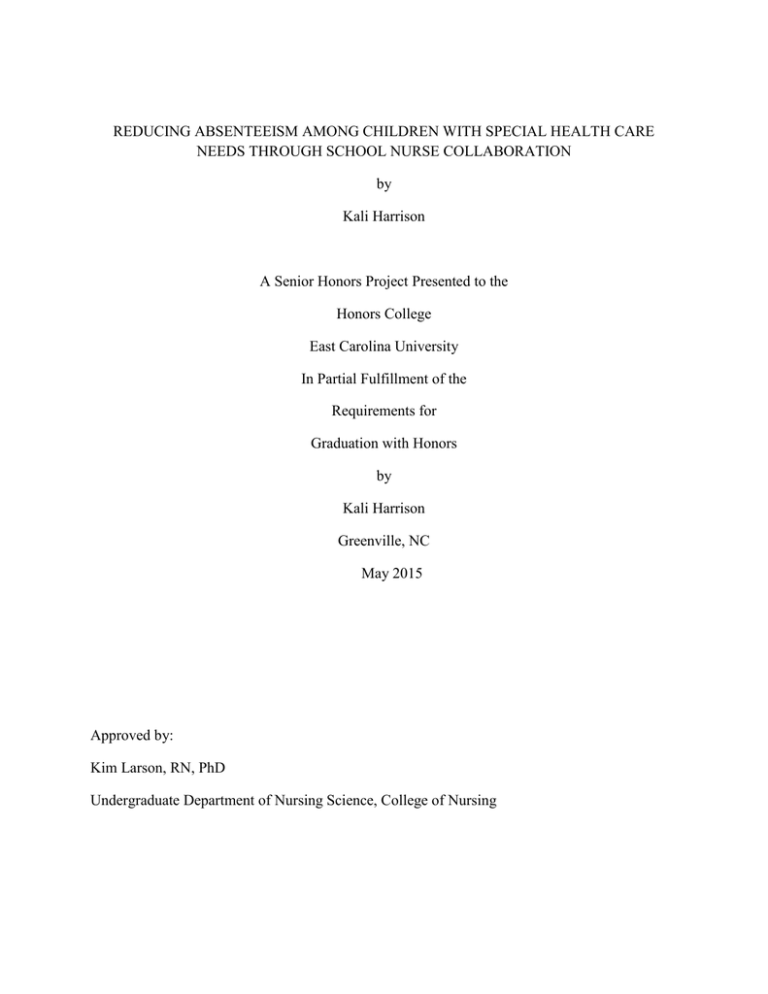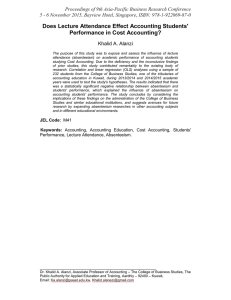REDUCING ABSENTEEISM AMONG CHILDREN WITH SPECIAL HEALTH CARE by
advertisement

REDUCING ABSENTEEISM AMONG CHILDREN WITH SPECIAL HEALTH CARE NEEDS THROUGH SCHOOL NURSE COLLABORATION by Kali Harrison A Senior Honors Project Presented to the Honors College East Carolina University In Partial Fulfillment of the Requirements for Graduation with Honors by Kali Harrison Greenville, NC May 2015 Approved by: Kim Larson, RN, PhD Undergraduate Department of Nursing Science, College of Nursing REDUCING ABSENTEEISM 2 INTRODUCTION This senior honors project was conducted as a part of a community health course in a baccalaureate nursing program. In this course, a senior nursing student completed the senior honors project in collaboration with a Registered Nurse (RN) preceptor in a community-based health care setting. The project included a targeted community health assessment, identification of a priority health need, plan of action, implementation and program evaluation. In spring 2015, as a senior nursing student, I developed a collaborative partnership with an elementary school nurse working in eastern North Carolina. In partnership with the school nurse the goal of this project was to evaluate programs in the school setting that reduce absenteeism among children with special health care needs (CSHCN). REVIEW OF LITERATURE The literature review included a computerized database search using CINAHL, MEDLINE via PubMed, One Search, & Google Scholar. Keywords used in the search were: school reintegration programs, school reentry, middle school, chronic illness in children, students with chronic illness, childhood cancer, school nursing, nurses’ role in school programs, absenteeism, homebound instruction and technology. Approximately 65 articles were identified; and 25 articles were relevant and applied to this project. Currently, schools are faced with the challenge of meeting the academic and developmental needs of a diverse student population. Chronic health conditions affect 10- 15% of American children (Duff, 2014), and the prevalence of chronic illnesses such as asthma, cancer, and diabetes has increased (Shiu, 2001). Maintaining a normal lifestyle plays an essential role in a child’s ability to effectively and positively adapt to a chronic illness. School REDUCING ABSENTEEISM 3 attendance can provide an opportunity for the child to help overcome short- and long-term cognitive, social, emotional and behavioral difficulties that may interfere with their overall functioning. The school environment provides the child with opportunities to develop in areas such as socialization, self-identity, problem solving, character building, confidence, ability to reason and social roles (Wirchel-Prevatt et al., 1998). Frequent and extended absences from school can disrupt the formation of peer relationships reducing the student’s social support and increasing peer rejection causing the student with health issues to become increasingly vulnerable to other life stressors and secondary illnesses (Shaw & MaCabe, 2008). Absenteeism plays a large role in determining a student’s achievements on both standardize tests and classroom performance. A strong negative correlation between absenteeism and achievement in math, reading comprehension, and reading vocabulary exist (Moonie, Sterling, Figgs & Castro, 2008). Students enrolled in public and private schools throughout North Carolina who had excessive absences (two or more weeks) exhibited an increased likelihood that they would receive below average grades (N.C. State Center for Health Statistics, 2011). In North Carolina, schools are required to have a minimum of 185 attendance days in their calendar year or provide 1,025 hours of classroom instruction to students (Public Schools of North Carolina State Board of Education, 2014). Attendance policies are established by the local board of education in each school district. Some children with chronic diseases exhibit frequent school absences as a result of routine treatments and/or medical complications. The North Carolina 2007- 2009 Statistics of School Absenteeism and Children’s Health Care completed by the Child Health Assessment and Monitoring Program reported that over a two year period 49% of parents reported that their child missed one to four days of school and 25% reported that their child missed five or more days of REDUCING ABSENTEEISM 4 school. Students who were absent for 10 or more days (9%) were found to have fair or poor general health and require more medical care, mental health or educational services (Statistics of School Absenteeism and Children’s Health, 2011). The overall mission of the school nurse is to prevent absenteeism. The role of the school nurse is to increase the efficacy and efficiency of school health services while advocating for safe care of students at school by fully meeting the health care needs of diverse school populations. It is the position of the National Association of School Nurses (NASN) to provide all children with special health care needs (CSHCN) coordinated and deliberate transition planning that focuses on the transitions at the beginning of a students’ school career, from school to school, school to adult life or between the hospital and school environment (National Association of School Nurses, 2012). In order to fulfill their role, school nurses along with a primary health care provider, parent/guardian, student, teachers, and other school staff coordinate knowledge and expertise in order to establish an individualized health plan (IHP) or individualized education plan (IEP) for the school-age child. These plans are implemented in order to promote student health and academic success thereby improving the quality of life for the child. Schools must be flexible in designing individualized education plans that adjust to the child’s medical regimen, which may include homebound instruction, flexible attendance and social support for students (Shaw & McCabe, 2008). The school nurse takes the lead in collaboration with school personnel to manage the health related issues of CSHCN, increasing the likelihood that students with frequent absences will remain in school and achieve their educational outcomes. REDUCING ABSENTEEISM 5 METHOD Setting This study took place in an elementary school in rural eastern North Carolina. The county has a diverse population of 60,000 and includes White (53%), Black (26%), and Latino (21%) residents (US Census Bureau, 2014). Approximately, 26% of the population lives below the federal poverty guidelines, higher than the state (18%) (US Census Bureau, 2014). The County Board of Education employs 14 full time school nurses who are registered nurses with a Bachelor’s degree. In addition, all 14 nurses are nationally certified in school nursing (S. E. Cottle, personal communication, April 10, 2015). School nurses use a multidisciplinary team approach, which includes students, teachers, social workers, various community organizations, guidance counselors, health care providers, and parents to coordinate and manage health care related learning needs. In 2013-2014, the county board of education reported a total of 2,482 CSHCN. These students required medication administration, case management, development and/or implementation of an Individual Health Plan (IHP) or Health Related 504 Plan. The management of CSHCN in schools takes place under the leadership of school nurses. This senior nursing student was assigned to work with a school nurse RN preceptor. The nursing student worked 1 or 2 days/week for 7 weeks. The elementary school serves over 951 students with grades spanning from Pre-k to 8th grade. This project focused on CSHCN in Pre-Kindergarten to 8th grade who have missed ten or more days of school. This population was chosen in accordance to the County School Attendance Policy, which indicates an increased risk of failure or grade retention. REDUCING ABSENTEEISM 6 Program Evaluation The School Health Nursing End of Year Report is compiled by the lead school nurse. The report is a composite of assessments completed by each school nurse to evaluate school-based programs and medical interventions for each local education agency. The report compiles total number of health education encounters, home visits, health concerns, health counseling, medications, injuries, health care procedures, screenings, referrals, and secured care. Prior to the 2013-2014 End of Year Report, a systematic approach to tracking students with chronic and or complex health care needs and absenteeism was not well developed. The major barriers to a systematic approach were an insufficient data collection plan and effective communication between all concerned members of the school health care team. This senior honors project evaluated processes in the school setting that intended to reduce absenteeism among CSHCN. In collaboration with the school nurse, the senior nursing students examined information through observation and a record audit. The school nurse identified CSHCN with 10 or more absences from school and the senior nursing student identified trends in school absences over time. Key informant interviews were completed with the school nurse and school social worker to further inform this project on resources available to CSHCN. The objectives of this project were to: a) evaluate and interpret descriptive data related to CSHCN and absenteeism, b) understand the role of the school nurse in collaboration with other school resources, and c) assess other resources used to prevent absenteeism among CSHCN. REDUCING ABSENTEEISM 7 FINDINGS This elementary school has a total of 271 CSHCN. The most common health conditions among CSHCN are presented in Figure 1. Of the identified students with special health care needs, 7.75% had missed 10 or more days of schools and were at risk for retention within their current grade level. Figure 1. Common health conditions of CSHCN at one Elementary School The school nurse works in collaboration with administration, teachers, social workers and parents in order to reduce absenteeism. This team meets every two weeks to ensure all members are fully informed of individual student matters and a line of communication between disciplines is clear and effective. School attendance trends for the past eight years are reported in Figure 2. Average daily attendance rates increased dramatically in 2013 as a result of 1) the introduction of weekly attendance letters, 2) the initiation of a truancy mediation committee, and 3) regular home visits to high-risk students by the school nurse and social worker team. School REDUCING ABSENTEEISM 8 nurses and social workers in this county completed 849 home visits in 2013-2014 with relation to absenteeism, chronic illness, IHP development and parent/family education. Figure 2. Average Daily Attendance Rate Years 2006-2013 Conclusion Reducing absenteeism is the responsibility of many individuals in the school system and therefore requires a systems approach. The coordinated outreach to parents of CSHCN with multiple absences through weekly letters, a truancy mediation committee, and home visits are strategies that effectively reduced school absenteeism. This project was developed as a way to evaluate a new system of reducing absenteeism among CSHCN. The new system including weekly letters, truancy mediation, and home visits increased communication and generation of data among the school health care team. Still, information regarding other processes, such as, tutoring and homebound instruction would be a valuable next step in program evaluation. REDUCING ABSENTEEISM 9 Reference Duff, C. (2014). School nurses—new roles for better outcomes. NASN School Nurse, 29, 216-218. doi: 10.1177/1942602X14545970 Moonie, S., Sterling, D., Figgs, L., & Castro, M. (2008). The Relationship Between School Absence, Academic Performance, And Asthma Status. Journal of School Health, 78(3), 140-148. National Association of School Nurses. (2012). Transition planning for students with chronic health conditions. Retrieved from: http://www.nasn.org/ N.C. State Center for Health Statistics. (2011). Statistics of School Absenteeism and Children’s Health Care. Retrieved from: http://www.schs.state.nc.us/ Public Schools of North Carolina State Board of Education. (2014). School Attendance and Student Accounting Manual 2014-2015. Retrieved from http://www.ncpublicschools.org Shaw, S. R., & McCabe, P. C. (2008). Hospital‐to‐school transition for children with chronic illness: Meeting the new challenges of an evolving health care system. Psychology in the Schools, 45(1), 74-87. doi:10.1002/pits.20280 Shiu, S. (2001). Issues in the education of students with chronic illness. International Journal of Disability, Development and Education, 48(3), 269-281., doi: 10.1080/10349120120073412 Wirchel-Prevatt, F. F., Heffer, R. W., & Lowe, P. A. (2000). A review of school reintegration programs for children with cancer. Journal of School Psychology, 38(5), 447-467. REDUCING ABSENTEEISM doi:10.1016/S0022-4405(00)00046-7 10



